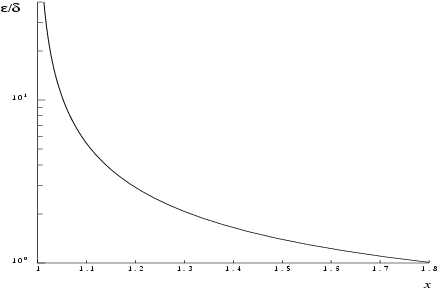s11ac returns the value of the inverse hyperbolic cosine, . The result is in the principal positive branch.
 Syntax
Syntax
| C# |
|---|
public static double s11ac( double x, out int ifail ) |
| Visual Basic |
|---|
Public Shared Function s11ac ( _ x As Double, _ <OutAttribute> ByRef ifail As Integer _ ) As Double |
| Visual C++ |
|---|
public: static double s11ac( double x, [OutAttribute] int% ifail ) |
| F# |
|---|
static member s11ac : x : float * ifail : int byref -> float |
Parameters
- x
- Type: System..::..DoubleOn entry: the argument of the function.Constraint: .
- ifail
- Type: System..::..Int32%On exit: unless the method detects an error or a warning has been flagged (see [Error Indicators and Warnings]).
Return Value
s11ac returns the value of the inverse hyperbolic cosine, . The result is in the principal positive branch.
 Description
Description
s11ac calculates an approximate value for the inverse hyperbolic cosine, . It is based on the relation
This form is used directly for , where , and the machine uses approximately decimal place arithmetic.
For , is equal to to within the accuracy of the machine and hence we can guard against premature overflow and, without loss of accuracy, calculate
 References
References
Abramowitz M and Stegun I A (1972) Handbook of Mathematical Functions (3rd Edition) Dover Publications
 Error Indicators and Warnings
Error Indicators and Warnings
Errors or warnings detected by the method:
- The method has been called with an argument less than , for which is not defined. The result returned is zero.
 Accuracy
Accuracy
If and are the relative errors in the argument and result respectively, then in principle
That is the relative error in the argument is amplified by a factor at least in the result. The equality should apply if is greater than the machine precision ( due to data errors etc.) but if is simply a result of round-off in the machine representation it is possible that an extra figure may be lost in internal calculation and round-off. The behaviour of the amplification factor is shown in the following graph:
Figure 1
It should be noted that for the factor is always less than . For large we have the absolute error in the result, in principle, given by
This means that eventually accuracy is limited by machine precision. More significantly for close to , , the above analysis becomes inapplicable due to the fact that both function and argument are bounded, , . In this region we have
That is, there will be approximately half as many decimal places correct in the result as there were correct figures in the argument.
 Parallelism and Performance
Parallelism and Performance
None.
 Further Comments
Further Comments
None.
 Example
Example
This example reads values of the argument from a file, evaluates the function at each value of and prints the results.
Example program (C#): s11ace.cs
